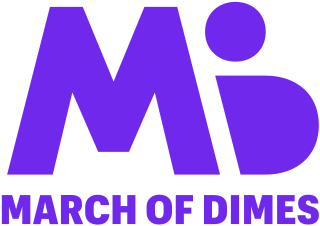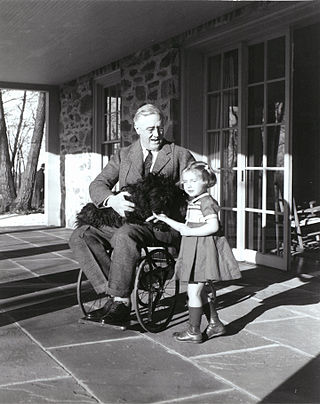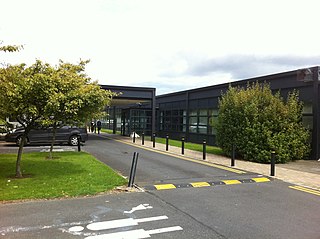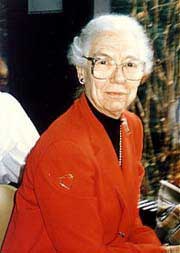Related Research Articles

Poliomyelitis, commonly shortened to polio, is an infectious disease caused by the poliovirus. Approximately 75% of cases are asymptomatic; mild symptoms which can occur include sore throat and fever; in a proportion of cases more severe symptoms develop such as headache, neck stiffness, and paresthesia. These symptoms usually pass within one or two weeks. A less common symptom is permanent paralysis, and possible death in extreme cases. Years after recovery, post-polio syndrome may occur, with a slow development of muscle weakness similar to that which the person had during the initial infection.

Polio vaccines are vaccines used to prevent poliomyelitis (polio). Two types are used: an inactivated poliovirus given by injection (IPV) and a weakened poliovirus given by mouth (OPV). The World Health Organization (WHO) recommends all children be fully vaccinated against polio. The two vaccines have eliminated polio from most of the world, and reduced the number of cases reported each year from an estimated 350,000 in 1988 to 33 in 2018.

March of Dimes is a United States nonprofit organization that works to improve the health of mothers and babies. The organization was founded by President Franklin D. Roosevelt in 1938, as the National Foundation for Infantile Paralysis, to combat polio. The name "March of Dimes" was coined by Eddie Cantor. After funding Jonas Salk's polio vaccine, the organization expanded its focus to the prevention of birth defects and infant mortality. In 2005, as preterm birth emerged as the leading cause of death for children worldwide, research and prevention of premature birth became the organization's primary focus.
Action Medical Research, previously The National Fund for Research into Crippling Diseases, is a British medical research charity, founded in 1952, that focusses on funding research to prevent and treat disease and disability in babies and children.

Sister Elizabeth Kenny was a self-trained Australian bush nurse who developed an approach to treating polio that was controversial at the time. Her method, promoted internationally while working in Australia, Europe and the United States, differed from the conventional one of placing affected limbs in plaster casts. Instead she applied hot compresses, followed by passive movement of the areas to reduce what she called "spasm". Her principles of muscle rehabilitation became the foundation of physical therapy or physiotherapy in such cases.

Knocknaheeny is an electoral division and suburb in Cork city, Ireland. Just over 2 km from the city centre, it is located north of the River Lee on hills overlooking the city. It is a mainly residential area, and contains a number of terraced council housing estates. Apple's headquarters for Europe is located here and employs about 5,000 people.

Movement for the Intellectually Disabled of Singapore (MINDS) is a voluntary welfare organisation based in Singapore, that provides services for the intellectually disabled. MINDS was founded in 1962, and remains one of the largest charities in Singapore. Over 600 staff and 2,400 beneficiaries are a part of MINDS. Two other organisations, the Association for Persons with Special Needs and Metta School were formed as an offshoot of MINDS.

Franklin D. Roosevelt, later the 32nd president of the United States from 1933 to 1945, began experiencing symptoms of a paralytic illness in 1921 when he was 39 years old. His main symptoms were fevers; symmetric, ascending paralysis; facial paralysis; bowel and bladder dysfunction; numbness and hyperesthesia; and a descending pattern of recovery. He was diagnosed with poliomyelitis and underwent years of therapy, including hydrotherapy at Warm Springs, Georgia. Roosevelt remained paralyzed from the waist down and relied on a wheelchair and leg braces for mobility, which he took efforts to conceal in public. In 1938, he founded the National Foundation for Infantile Paralysis, leading to the development of polio vaccines. Although historical accounts continue to refer to Roosevelt's case as polio, the diagnosis has been questioned in the context of modern medical science, with a competing diagnosis of Guillain–Barré syndrome proposed by some authors.
A group home, congregate living facility, care home, adult family home, etc., is a structured and supervised residence model that provides assisted living and medical care for those with complex health needs. Traditionally, the model has been used for children or young people who cannot live with their families or afford their own homes, people with chronic disabilities who may be adults or seniors, or people with dementia and related aged illnesses. Typically, there are no more than six residents, and there is at least one trained caregiver there 24 hours a day. In some early "model programs", a house manager, night manager, weekend activity coordinator, and four part-time skill teachers were reported. Originally, the term group home referred to homes of 8 to 16 individuals, which was a state-mandated size during deinstitutionalization. Residential nursing facilities, also included in this article, may be as large as 100 individuals in 2015, which is no longer the case in fields such as intellectual and developmental disabilities. Depending on the severity of the condition requiring one to need to live in a group home, some clients are able to attend day programs and most clients are able to live normal lifestyles.

The Central Remedial Clinic, commonly known and referred to as the CRC, is a non-residential national centre established for the care, treatment and development of children and adults with physical disabilities. It is located at Clontarf, Ireland.

The history of polio (poliomyelitis) infections began during prehistory. Although major polio epidemics were unknown before the 20th century, the disease has caused paralysis and death for much of human history. Over millennia, polio survived quietly as an endemic pathogen until the 1900s when major epidemics began to occur in Europe. Soon after, widespread epidemics appeared in the rest of the world. By 1910, frequent epidemics became regular events throughout the developed world primarily in cities during the summer months. At its peak in the 1940s and 1950s, polio would paralyze or kill over half a million people worldwide every year.
Post-Polio Health International (PHI) is a relatively new name for a non-profit organization that officially began its work in 1960. For many years it was known in medical, rehabilitation, and disability circles variously as GINI, or the International Polio Network, or the Rehabilitation Gazette Network, or more familiarly as Gini’s Network, in honor of Gini Laurie, its founder and driving force until her death in 1989.

Virginia Grace Wilson "Gini" Laurie was a central figure in the 20th century development, in the United States, of the independent living movement for people with disabilities. It is sometimes said that she was one of its two "grandmothers"—the other one being Mary Switzer, who was in charge of vocational rehabilitation at the national level from 1950 to 1970.

Nicklaus Children's Hospital formerly known as Miami Children's Hospital is a hospital for children in South Florida. The hospital has 289 beds. It is affiliated with the FIU Herbert Wertheim College of Medicine, Nova Southeastern University, and St. George's University and is a member of Nicklaus Children's Health System. The hospital provides comprehensive pediatric specialties and subspecialties to pediatric patients aged 0–21 throughout South Florida. Nicklaus Children's Hospital features the only Level 1 pediatric trauma center in the region, and 1 of 3 in the state. It has 650 attending physicians and over 130 pediatric sub-specialists. Nicklaus Children's Hospital was one of the largest employers in Miami-Dade County in 2014 with over 3,500 employees.
TIRR Memorial Hermann is a 134-bed rehabilitation hospital, rehabilitation and research center, outpatient medical clinic and network of outpatient rehabilitation centers in Houston, Texas that offers physical rehabilitation to patients following traumatic brain or spinal injury or to those suffering from neurologic illnesses.
The Rehab Group is an international not-for-profit organisation providing health and social care, training and education, rehabilitation, employment and commercial services. Operating primarily in Ireland and the United Kingdom, it was originally established in 1949 as the Rehabilitation Institute, and provided training services to people with tuberculosis. In 2014 and 2015, a number of controversies involving the Rehab Group resulted in the resignation of the organisation's then CEO, a reduction in donations to several charities, and changes to the regulation of charities in Ireland.
For many elderly carers of a relative who has a learning or other disability, future planning is an issue. The population of older parents who have children with a learning disability is growing and many of their children are likely to outlive them. In many cases the caring role can span up to seven decades, ending only with their death. Governments and other service providers cannot ignore the pressing needs of this population and their parent and sibling carers. In most countries, family carers provide inexpensive care for a person with a learning disability and other disabilities. This trend is set to continue in England. Demographic changes and the health needs of these two growing populations must be considered against government policy constraints and limited in-home and external care options in order to avoid a crisis. The consequences of not supporting these family carers will lead to crisis management, increase in distress and care giving burdens, and increased spending on unsuitable crisis placements. Housing and financial guidance are issues for caregivers.
The Courage Kenny Rehabilitation Institute is a rehabilitation medicine institute in Minneapolis, United States.

The 1916 New York City polio epidemic was an infectious disease epidemic of polio ultimately infecting several thousand people, and killing over two thousand, in New York City, primarily in the borough of Brooklyn. The epidemic was officially announced in June 1916, and a special field force was assembled under the authority of Dr. Simon R. Blatteis of the New York City Health Department's Bureau of Preventable Diseases, with broad authority to quarantine those infected with polio and institute hygiene measures thought to slow the transmission of the disease. Polio was a poorly understood disease in this era, and no polio vaccine existed at this time. Official efforts to stem its spread consisted primarily of quarantines, the closure of public places, and the use of chemical disinfectants to cleanse areas where the disease had been present. Special polio clinics were established at various locations in the city for the treatment and quarantine of patients.
Dr Barbara Stokes MB BCh BAO was an Irish paediatrician and disability campaigner.
References
- ↑ "Cope Foundation | Inclusion Ireland". Inclusion Ireland. Archived from the original on 24 September 2015. Retrieved 7 December 2012.
- ↑ "The 1956 polio epidemic in Cork". History Ireland. 20 February 2013. Retrieved 23 December 2013.
- ↑ "A Brief History". Cope Foundation. Archived from the original on 25 February 2012. Retrieved 7 December 2012.
- ↑ "Cope Foundation launches #WhoIMiss fundraiser to enable isolated residents stay in touch with families". www.irishexaminer.com. 15 April 2020. Retrieved 15 April 2020.
- ↑ "All Service Locations | COPE Foundation". COPE Foundation. Archived from the original on 8 February 2013. Retrieved 7 December 2012.
- ↑ "Cope Foundation". Top 1000 Irish Companies. Irish Times. 2013. Retrieved 23 December 2013.
- ↑ "Annual Report December 2011". Cope Foundation. Archived from the original on 24 December 2013. Retrieved 7 December 2012.